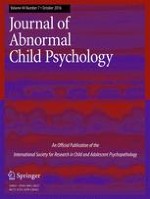15-01-2016
Sexual Risk Behaviors in the Adolescent Offspring of Parents with Bipolar Disorder: Prospective Associations with Parents’ Personality and Externalizing Behavior in Childhood
Gepubliceerd in: Research on Child and Adolescent Psychopathology | Uitgave 7/2016
Log in om toegang te krijgenAbstract
We recently reported that adolescent and young adult offspring of parents with bipolar disorder (OBD), relative to control offspring, were more likely to engage in sexual risk behaviors (SRBs). The present prospective study aimed to determine the contribution of parents’ personality and offspring behaviour problems in middle childhood to offspring SRBs 10 years later. We hypothesized that offspring externalizing problems in childhood would mediate the relationship between parents’ personality traits of neuroticism and agreeableness and adolescent SRBs. Furthermore, we expected these associations to be more robust among the OBD than controls. At baseline, 102 offspring (52 OBD and 50 controls) aged between 4 and 14 years were assessed along with their parents, who completed a self-report personality measure and child behavior rating. Behaviour ratings were also obtained from the children’s teachers. Ten years later the offspring completed an interview assessing SRBs. Mediation analyses using bootstrapping revealed that, after controlling for age and presence of an affective disorder, externalizing behaviors served as a pathway through which high parental neuroticism, low parental agreeableness, and low parental extraversion were related to SRBs in offspring. Moderated mediation analyses revealed that the relationship between parental neuroticism and childhood externalizing problems was stronger for OBD than controls. These findings add to our previous results showing parents’ personality contributes to intergenerational risk transfer through behavioral problems in middle childhood. These results carry implications for optimal timing of preventative interventions in the OBD.
